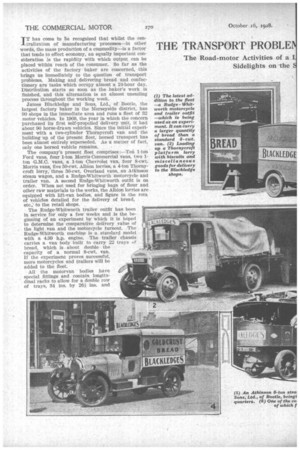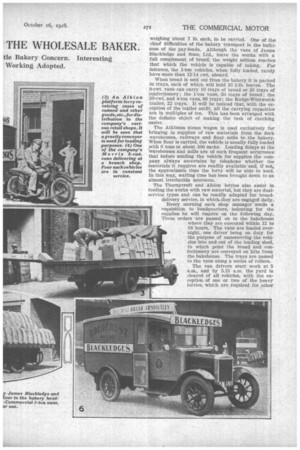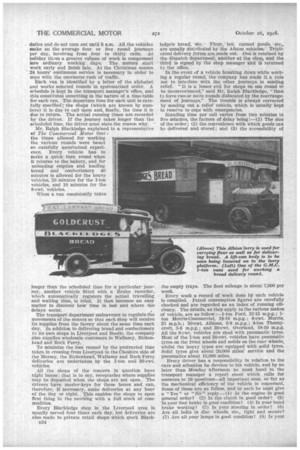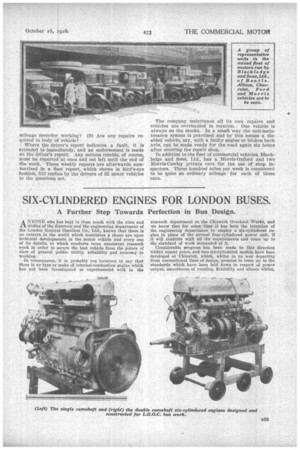THE TRANSPORT PROUD THE WHOLESALE BAKER.
Page 16

Page 17

Page 18

Page 19

If you've noticed an error in this article please click here to report it so we can fix it.
The Road-motor Activities of a L Sidelights on the tie Bakery Concern. Interesting Working Adopted.
IT has come to be recognized that whilst the centralization of manufacturing processes—in other words, the mass production of a commodity—is a factor that tends to effect economy, an equally important consideration is the rapidity with which output can be placed within reach of the consumer. So far as the activities of the factory baker are concerned, this brings us immediately to the question of transport problems. Making and delivering bread and confectionery are tasks which occupy almost a 24-hour day. Distribution starts so soon as the baker's work is finished, and this alternation is an almost unending process throughout the working week.
James Blackledge and Sons, Ltd., of Bootle, the largest factory baker in the Merseyside district, has 90 shops in the Immediate area and runs a fleet of 32 motor vehicles. In 1909, the year in which the concern purchased its first self-propelled delivery unit, it had about 90 horse-drawn vehicles. Since the initial experiment with a two-cylinder Thornycroft van and the building up of the present fleet, horsed transport has been almost entirely superseded. As a matter of fact, only one horsed vehicle remains. • The company's present fleet comprises :—Ten 1-ton Ford vans, four 1-ton Morris-Commercial vans, two 1ton G.M.C. vans, a 1-ton Chevrolet van, four 8-cwt. Morris vans, five 50-cwt. Albion lorries, a 4-ton Thornycroft lorry, three 30-cwt. Overland vans, an Atkinson steam wagon, and a Rudge-Whitworth motorcycle and trailer van. A second Rudge-Whitworth outfit is on order. When not used for bringing bags of flour and other raw materials to the works, the Albion lorries are equipped with lift-van bodies, and figure in -the rota of vehierles detailed for the delivery of bread, etc.,' to the retail shops.
The Rudge-Whitworth trailer outfit has been in service for only a few weeks and is the beginning of an experiment by which it is hoped to determine the comparative delivery value of the light ,van and the motorcycle turnout. The Rudge-Whitworth machine is a standard model with a 4.99 h.p. engine. The trailer chassis carries a van body built to carry 22 trays of bread, which is about double the capacity of a normal 8-cwt. van. If the experiment proves successful, more motorcycles and trailers will be added to the fleet.
• All the motorvan bodies have special fittings and contain longitudinal racks to allow for a double row of trays, 34 ins. by 26} ins. and
weighing 'about 7 lb. each, to be carried. One of the chief difficulties of the bakery transport is the bulkiness of the pay-loads. Although the vans of James Blackledge and Sons, Ltd., leave the works with a full complement of bread, the weight seldom reaches that which the vehicle is capable of taking. For instance, the 1-ton vehicles, when fully loaded, rarely have more than 12-14 cwt. aboard.
When bread is sent out from the bakery it is packed in trays, each of which will hold 20 2-lb. loaves. The 8-cwt. vans can carry 10 trays of bread or 20 trays of confectionery ; the 1-ton vans, 30 trays of bread ; the 50-cwt. and 4-ton vans, 60 trays; the Rudge-Whitworth trailer, 22 trays. It will be noticed that, with the exception of the trailer outfit, all the carrying capacities are in multiples of ten. This has been arranged with the definite object of making the task of checking easier.
The Atkinson steam wagon is used exclusively for -bringing in supplies of raw materials from the dock warehouses, railways and flour, mills to the bakery. When flour is carried, the vehicle is usually fully loaded with 6 tons or about 100 sacks. Loading delays at the Warehouses and mills are of such frequent occurrence that before sending the vehicle for supplies the company always ascertains by telephone whether the materials it requires are readily available and, if not, the approximate time the lorry will be able to load. In this way, waiting time has been brought down to an almost irreducible minimum.
The Thornycroft and Albion lorries also assist in feeding the works with raw material, but they are dualservice types and can be readily adapted for breaddelivery service, in which, they are engaged daily.
Every morning each shop manager sends a requisition to headquarters, indenting for the supplies he will require on the following day. These orders are passed on to the bakehouse where they are executed within 12 to 18 hours. The vans are loaded overnight, one driver being on duty for the purpose of manceuvring the vehicles into and out of the loading shed, to which point the bread and confectionery are conveyed on lifts from the Bakehouse. The trays are passed to the vans along a series of rollers.
The van drivers start work at 5 a.m., and by 5.15 a.m. the yard is cleared of all vehicles, with the exception of one or two of the heavy lorries, which are required for ,other
duties and do not turn out -until 8 a.m. All the vehicles make on the average four or five round journeys per day, involving from four to thirty calls. At holiday tiwes a greater volume of work is compressed Into ordinary working days. The Motors start work early and finish late. At the Christmas season 24 hours' continuous service is necessary in order to cope with the enormous rush of traffic.
Each van is identified by a letter of the alphabet and works selected rounds in systematized order. A Schedule is kept in the transport manager's office, and this constitutes something in the nature of a time-table for each van. The departure time for each unit is carefully specified ; the shops (which are known by numbers) it is due to call upon and, finally, the time it is due to return. The actual running times are recorded by the driver. If the journey take S longer than the scheduled time, the driver must state the reason why. '
Mr. Ralph Blackledge explained to a representative of The. Commercial Motor that the times allowed for working the various rounds were based on carefully ascertained experience. Every vehicle has to make a quick turn reimd when It returns to the bakery, and for unloading empties and loading bread and confectionery 40 minutes is allowed or the heavy vehicles, 20 minutes for the 1-ton vehicles, and 10 minutes for the 8-cwt. vehicles.
When a van consistently takes • longer than the scheduled time for a particular journey, another vehicle fitted with a Bruhn recorder,. which automatically registers the actual travelling and waiting time, is tried. It then becomes an easy matter to discover how time is lost and where the delays occur.
The transport department endeavours to regulate the movements of the motors so that each shop will receive its supplies from the faeory about the same time each day. In addition to delivering bread and confectionery to its own shops in Liverpool and Bootle, the company also supplies wholesale customers in Wallasey, Birkenhead and Rock Ferry.
To minimize the loss caused by the protracted time taken in crossing from Liverpool to the Cheshire side of the Mersey, the Birkenhead, Wallasey and Rock Ferry deliveries are undertaken by the 1-ton and 30-cwt. vehicles.
All the shops of the concern in question have night boxes; that is to say, reeeptacIe3 where supplies may he deposited when the shops are not open. The drivers have master-k.eys for these boxes and can, therefore, if necessary, make deliveries at any hour of the day or night. This enables the shops to open first thing in the morning with a full stock of commodities.
Every Blackledge shop in the Liverpool area is usually served four times each day, but deliveries are also made to private retail shops•which stock Blacka34 ledge's bread, etc. ' Flour, tea; canned goods, etc., are usually distribeted by the Albion vehicles. Triplicated delivery forms are made out. One is retained by the dispatch department, another at the shop, and the third is signed by the shop manager and is returned t)• the office.
In the event of a vehicle breaking down while working a regular round, the company has made it a rule not to intecfere with the other journeys in sending relief. "It is a lesser evil for shops on one round to be inconvenienced," said Mr. Ralph Blackledge, "than ta have two or more rounds dislocated by the rearrangement of journeys." The trouble is always corrected by sending out a relief vehicle, which is usually kept in reserve to cope with emergencies.
Standing time per call varies from two minutes to five minutes, the factors of delay being:—(1) The size of the order ; (2) the convenience with which goods can bo, delivered and stored ; and (3) the accessibility of
the empty trays. The fleet mileage is about 7,000 per week.
Every week a record of work done by each vehicle is compiled. Petrol consumption figures are carefully checked and are regarded as an index of running efficiency. The details, as they apply to the various makea of vehicle, are as follow :-1-ton Ford, 12-15 m.p.g.;. ton Morris-Commercial, 18-19 m.p.g. ; 8-cwt. Morris, 25 m.p.h.; 50-cwt. Aliaions, 6-8 m.p.g.; 4-ton Thornycroft, 5-6 m.p.g.; and 30-cwt. Overland, 18-19 m.p.g. All the 8-cwt. vehicles are shod with pneumatic tyres. Most of the 1-ton and 30-cwt. vehicles have pneumatic tyres on ihe front wheels and solids on the rear wheels, whilst the heavy types are equipped with solid tyres. Solid tyres give about 20,000 miles' service and the pneumatics about 15,000 miles.
Every driver has a responsibility in relation to the care and attention he devotes to his vehicle, and by no later than Monday afternoon he must hand to the transport manager a report sheet which calls for answers to 16 questions—all important ones, so far as the mechanical efficiency of the vehicle is concerned. Some of these are as follow, and to each he must give "Yes" or " " reply.—(1) Is the engine in good general order? (2) Is the clutch in good order? (3) 'Is your foot brake in good condition? (4) Is your band brake working? (5) Is your steering in order? (6) Are all bolts in disc wheels, etc., tight and secure? (7) Are all your lamps in good condition? (8) Is your mileage recorder working? (9) Are any repairs re • quired to body of vehicle?
" Where the driver's report indicates a fault, • it is attended to immediately, and an endorsement is made on the driver's report: Any serious trouble, of course, must be reported at once and not left until the end of the "week.' These weekly reports are afterWards summarized in a fleet report, which shows in bird's-eye fashion, 512 replies by the drivers of 32 motor vehicles to the queitions set.
The company undertakes all its own repairs and vehicles are overhauled in rotation. One vehicle is always on the stocks. In a small way the unit-maintenance system is practised and by this means a disabled vehicle, say, with a faulty engine or broken back axle, can be made ready for the road again six hours after entering the repair shop.
In addition to the fleet of commercial vehicles, Blackledge and Sons, Ltd., has a Morris-Oxford and two Morris-Cowley private cars for the use of shop inspectors. Three hundred miles per week is considered to be quite an ordinary mileage for each of these cars.
































